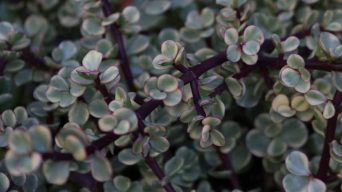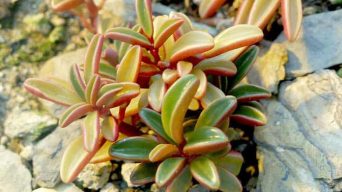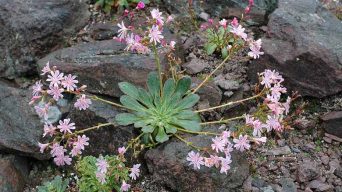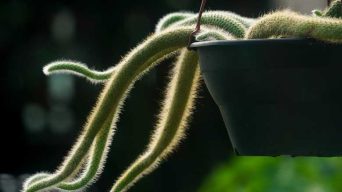Growing the Elephant Bush (Portulacaria afra) is pretty easy; they will grow fast and easily propagate.
Portulacaria afra is one of the most popular and common succulent plants in the world, and it’s relatively easy to grow.
It grows best outdoors in sunny, dry climates, but it can also be grown indoors as houseplants.
As long as you choose healthy plants and give them proper care, they’ll grow pretty quickly.
This article will guide you through the care and propagation of this easy to grow succulent plant.
Overview
Portulacaria afra, commonly known as the Elephant Bush plant, is a large succulent shrub from South Africa that belongs to the Didiereaceae family.
Elephant Bush plants have reddish-brown stems with small fleshy green leaves and can grow up to 20 feet (6 meters) tall in their natural habitat.
However, as a houseplant, it’s more likely to remain just a few feet tall (around 1 m.).
The Portulacaria afra plant’s common names include:
- Elephant Bush
- Dwarf Jade Plant
- Porkbush
- Spekboom
The name Elephant bush is a reference to the elephant’s liking for eating this plant.
Portulacaria afra plants have been used in different parts of Africa as a food source by humans and animals alike.
How To Care for Portulacaria Afra (Elephant Bush)
Elephant Bush care is relatively easy, which is one of the reasons why it is so popular.
Below you’ll find the essential information you need to know about caring for Portulacaria afra ‘Elephant Bush’.
Sun Exposure & Light Requirements
Elephant Bush plants like full sun to partial shade. This plant grows best in bright, indirect light. They would do best in a brightly lit room or on a covered porch.
If grown indoors, place Portulacaria afra plants somewhere sunny and make sure the plant is not exposed to intense direct sunlight, especially during the hottest parts of the day.
They can be grown outdoors as an indoor-outdoor plant, as long as they are given adequate sun exposure and the weather is not too hot.
The Portulacaria afra succulent thrives when it has at least 4 to 5 hours of bright light daily.
They would do fine in an area with morning sun and afternoon shade. If grown outdoors, they can be placed directly under the sun if the weather permits.
A west or east-facing window with a few hours of direct sun is recommended if you’re growing the plant indoors.
This plant does not do well in full shade or very low light conditions because it needs sufficient light to perform photosynthesis.
Watering Requirements
Portulacaria afra plant does not need to be watered often. It needs to be watered around once every week, depending on the temperature and humidity in your area.
The Portulacaria afra needs to be well-drained and watered only when the soil has dried out completely.
Like every other succulent, The Elephant Bush should be watered so that the soil is completely soaked and water starts dripping out of the drainage hole.
It does not like to have soggy soil, so make sure you do not overwater.
Overwatering can cause root rot and is a common cause of death among succulents, including Portulacaria afra.
Soil Requirements
Portulacaria afra requires soil that drains well and is nutrient-rich.
The ideal soil should be able to retain some moisture while also being able to drain excess water after watering.
It is recommended a cactus or succulent potting mix be used.
A standard potting soil mixed with extra perlite and coarse sand can be used if a commercial potting mix is unavailable.
An ideal succulent mix would be 2 parts commercial potting soil, 1 part perlite or gravel, and 1 part coarse sand.
Temperature and Humidity
The temperature requirements of the Elephant Bush are between 15°C – 30°C during its growing season.
It can survive in temperatures as low as 5°C to 10°C, but the plant will be more susceptible to rot if not brought indoors or covered with cloth.
The humidity around the Portulacaria afra also needs to be between 30 – 50%; any less than that, and the plant may experience wilting.
Fertilizing
There is no reason to fertilize your Portulacaria afra, but you can if you want.
If you choose to use fertilizer on your Elephant bush, use it sparingly, once every two months during the growing season.
Any more than that or less than that will do damage to or kill your plant.
Use a balanced liquid fertilizer diluted to half-strength, and it should only be applied to the soil, not the leaves.
Fertilize your plants only in the spring and summer, not during the winter months.
Potting and Repotting
As the Elephant Bush grows and older, repotting the plant into a larger pot will become necessary.
If you buy an Elephant plant from the store, this should not need to occur until 2-3 years after you purchase it.
When you are ready to repot, find a pot at least 1″ larger than the previous container of the Elephant Bush.
If your plant has been in its current pot for more than two or three years, then you will likely want to repot it into a container that is 2″ larger than the previous one.
The best time to repot your Elephant Bush is in the spring, during late March or early April before new leaf growth begins – although you can do it at any point of the year.
When choosing a pot to use for repotting, there are several things to take into consideration.
You want to choose a pot with drainage holes so water can flow easily through the container, but you don’t want the soil of the Elephant Bush to sit in water after it is watered.
If your pot does not have drainage holes, create some by using a drill or sharp knife.
Pruning
The Portulacaria afra ‘Elephant Bush’ is a relatively slow-growing tree that can grow large if left unpruned.
If you want to slow down the growth rate of your tree, then prune it back roughly 1-2 times per year.
Frequent pruning is necessary because Portulacaria afra can get quite large and need to be pruned down to maintain a tidy landscape.
On the other hand, if you do not want your Portulacaria afra ‘Elephant Bush’ to grow too tall, you should prune out all of the branches from the lower half of its trunk when it gets tall enough to cast shade over the roots.
New, smaller branches will grow in their place, and your tree can continue growing with mainly trunk height branches.
This way, you prevent your tree from getting too tall before it starts to branch out, and you can keep the Portulacaria afra ‘Elephant Bush’ under about 1 meter in height.
Also, removing damaged and dead leaves stems, and branches is very important for your tree’s health.
If you prune off dead portions of the plant, it will help it grow faster, while removing damaged parts will help prevent the spread of infections caused by fungi, bacteria, and pests that often hide in damaged leaves.
Pests and Diseases
The Elephant Bush succulent has few issues with pests and diseases if the plant is not kept in a humid environment.
However, if kept in a humid environment, they can become prone to mealybugs and fungal infections.
Mealybugs
Mealybugs are small and will look like white cotton covering the leaves and stems of the plant.
They cluster together in patches on the leaves’ underside and near the stem’s center. If left untreated, mealybugs can destroy a succulent plant.
To remove mealybugs from your Portulacaria afra, use a cotton swab dipped in rubbing alcohol.
Do not use spray insecticides unless it is necessary because they can damage the plant or spread to other plants around it.
Fungus
Fungus is a concern because it will grow and spread very quickly.
The fungus appears as small, dark brown or black dots on the leaves and stems. If left untreated, fungal infection can weaken the plant, cause the leaves to fall off, and eventually kill it.
If you think your plant has fungus, clean and sterilize all tools that come into contact with the plant.
Remove any dead leaves, stems, and flowers because these may be hiding fungus. Treat the entire plant with a fungicide if you find signs of fungus after removing the leaves or flowers.
How to Care for Portulacaria Afra (Elephant Bush) in Winter
The Portulacaria afra is hardy in USDA zones 9-11.
If you are in a colder region, the Elephant bush will not survive the winter outdoors.
Instead, keep it indoors in a bright, cool location with plenty of indirect sunlight.
It will only need water every two to three weeks, so allow it to get pretty dry to induce new growth.
Alternatively, you can bring the plant back outside in the spring when the temperatures are warm enough for it to survive outdoors.
If you live in a place with mild winters, the Portulacaria afra can grow outdoors in a protected area that receives a few hours of direct sunlight each day.
Just keep it well watered throughout the winter and protect your plant from frost by bringing it indoors when temperatures dip below freezing.
How To Propagate Portulacaria Afra (Elephant Bush)
Portulacaria afra is a straightforward plant to propagate. It probably wouldn’t be the first succulent you should try propagating, but after a little while of growing it, you’ll know what you can do with it.
The Elephant Bush can be easily propagated through stem cuttings. To propagate it through stem cuttings:
- Cut a new clean stem from the mother plant
- Let the cut end dry out and callous over for a day or two. This will prevent the plant from rotting when you put it in the soil.
- Place the cuttings in a pot with some cactus mix (or similar succulent soil) and let the end that was cut touch the soil.
- Keep moist, but not too wet. Succulents do not like sitting in water.
- Place the new cutting in a window that gets a lot of sunlight, where it will get plenty of light.
- The cutting should eventually root, and new growth should appear. It may take a few weeks or months for this to happen, depending on the cutting.
- You can plant the cutting in your garden or pot when it has rooted. Make sure it gets lots of sunlight.
If you are planting in a pot, try to use a big enough pot that the roots will have room to grow for at least another year before transplanting into the ground.
If you are planting it in the ground, make sure you pick a place where it will have plenty of sunlight for at least another year before moving to a shadier spot.
Final Thoughts
Growing succulents is a fun, rewarding hobby that is easy to start.
It can be very satisfying to grow life from the soil with just the addition of water and sunlight.
Portulacaria afra care and propagation are not too difficult. It can be an excellent project for children or gardeners that are new to succulents.
While growing your Portulacaria afra from a cutting is a bit more advanced, it is still possible and rewarding if you have the patience.
Most importantly, have fun growing these unusual plants!







